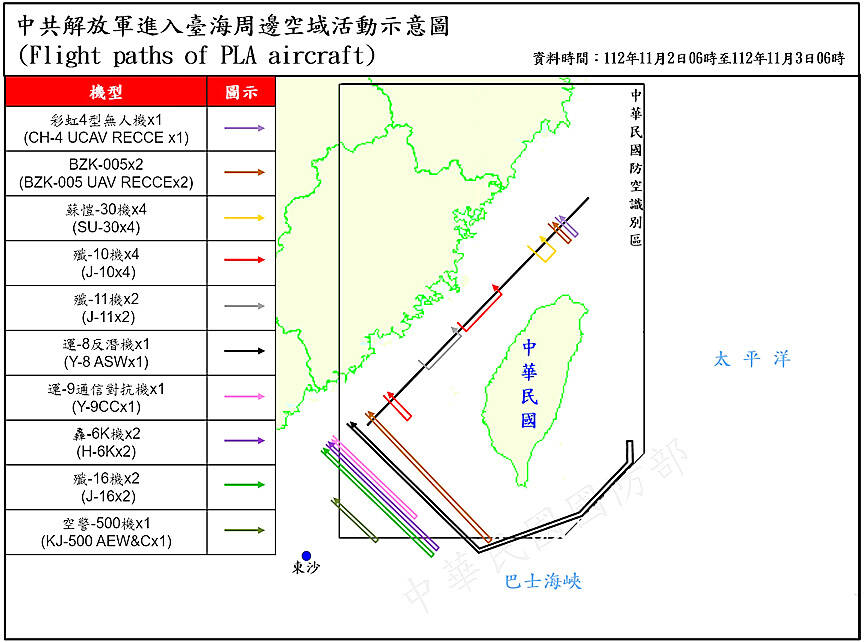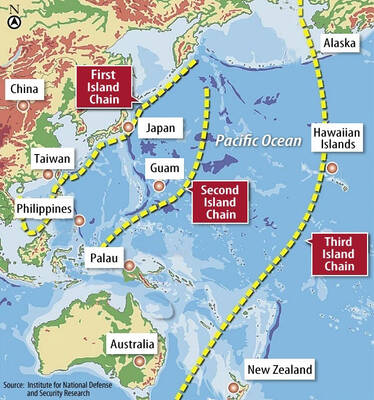The military scrambled aircraft from Thursday to yesterday after spotting 20 Chinese warplanes crossing the median line of the Taiwan Strait, the Ministry of National Defense said.
The ministry in a statement said that 39 Chinese People’s Liberation Army (PLA) aircraft and eight PLA Navy vessels were detected in the waters around Taiwan in the 24 hours ending at 6am yesterday.
Twenty of the aircraft crossed the median line of the Taiwan Strait or entered the nation’s southwest or southeast air defense identification zones (ADIZ), it said.

Photo courtesy of the Ministry of National Defense
The aircraft include one CH-4 reconnaissance drone, two Harbin BZK-005 high-altitude long-range drones, four Sukhoi Su-30 fighter jets, four Chengdu J-10 fighters, two Shenyang J-11 fighters, one Shaanxi Y-8 transport aircraft, one Shaanxi Y-9 transport aircraft, two Xian H-6 bombers, two Shenyang J-16 fighters and one Shaanxi KJ-500 airborne early warning and control aircraft, it said.
The military sent aircraft to warn away the planes, while missile systems monitored them, the ministry said, using standard wording for its response.
The government believes the frequent Chinese military activities near Taiwan this week, including reporting 37 Chinese aircraft in the ADIZ from Wednesday to Thursday, are meant to exert pressure on the US amid a series of high-level talks between Beijing and Washington, a senior security official said.
“China is used to maximizing its military pressure amid negotiations,” said the official, who declined to be named due to the sensitivity of the matter. “They want to increase their bargaining chips.”
Earlier this week, the US destroyer USS Rafael Peralta and a Royal Canadian Navy frigate HMCS Ottawa transited the Taiwan Strait, a maneuver that was followed and monitored by the Chinese military.

WANG RELEASED: A police investigation showed that an organized crime group allegedly taught their clients how to pretend to be sick during medical exams Actor Darren Wang (王大陸) and 11 others were released on bail yesterday, after being questioned for allegedly dodging compulsory military service or forging documents to help others avoid serving. Wang, 33, was catapulted into stardom for his role in the coming-of-age film Our Times (我的少女時代). Lately, he has been focusing on developing his entertainment career in China. The New Taipei District Prosecutors’ Office last month began investigating an organized crime group that is allegedly helping men dodge compulsory military service using falsified documents. Police in New Taipei City Yonghe Precinct at the end of last month arrested the main suspect,

A cat named Mikan (蜜柑) has brought in revenue of more than NT$10 million (US$305,390) for the Kaohsiung MRT last year. Mikan, born on April 4, 2020, was a stray cat before being adopted by personnel of Kaohsiung MRT’s Ciaotou Sugar Refinery Station. Mikan was named after a Japanese term for mandarin orange due to his color and because he looks like an orange when curled up. He was named “station master” of Ciaotou Sugar Refinery Station in September 2020, and has since become famous. With Kaohsiung MRT’s branding, along with the release of a set of cultural and creative products, station master Mikan

Eleven people, including actor Darren Wang (王大陸), were taken into custody today for questioning regarding the evasion of compulsory military service and document forgery, the New Taipei District Prosecutors’ Office said. Eight of the people, including Wang, are suspected of evading military service, while three are suspected of forging medical documents to assist them, the report said. They are all being questioned by police and would later be transferred to the prosecutors’ office for further investigation. Three men surnamed Lee (李), Chang (張) and Lin (林) are suspected of improperly assisting conscripts in changing their military classification from “stand-by

LITTORAL REGIMENTS: The US Marine Corps is transitioning to an ‘island hopping’ strategy to counterattack Beijing’s area denial strategy The US Marine Corps (USMC) has introduced new anti-drone systems to bolster air defense in the Pacific island chain amid growing Chinese military influence in the region, The Telegraph reported on Sunday. The new Marine Air Defense Integrated System (MADIS) Mk 1 is being developed to counter “the growing menace of unmanned aerial systems,” it cited the Marine Corps as saying. China has constructed a powerful defense mechanism in the Pacific Ocean west of the first island chain by deploying weapons such as rockets, submarines and anti-ship missiles — which is part of its anti-access/area denial (A2/AD) strategy against adversaries — the